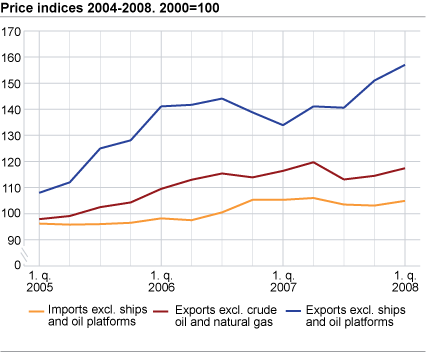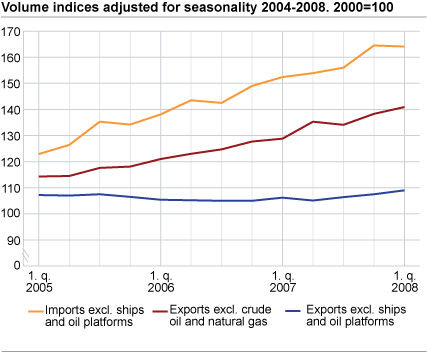Content
Published:
This is an archived release.
Higher machine prices causes higher import prices
Import prices of goods excluding ships and oil platforms increased from the fourth quarter of 2007 to the first quarter of 2008. The increase is mainly due to higher prices of machinery.
Import prices of goods excluding ships and oil platforms increased by 1.8 per cent in the first quarter of 2008 compared to the fourth quarter of 2007. Prices were higher in most groups, particularly manufactured goods such as machinery.
The machine prices increased 2.9 per cent. The prices of machines such as power generating machinery, telecommunications equipment, electrical machinery and road vehicles went up 9, 6, 2 and 1 per cent respectively.
Prices of food products were also higher. The price of food groups such as dairy and eggs, cereals, and vegetables and fruits went up 7, 4 and 8 per cent respectively. It seems that the price level of some goods may have been affected by higher prices on the world market.
Import prices of goods excluding ships and oil platforms did however decrease by a slight 0.3 per cent in the first quarter of 2008 if compared to the same quarter in 2007. A major 41.2 per cent increase in fuel prices did not offset the downward trend in crude materials which fell12.8 per cent.
Higher import prices of consumer goods
The low-cost countries in the East have experienced an increase in the level of salaries and production costs. This has led to higher prices on the products imported to Norway.. The development in the first quarter of 2008 shows that the prices of some consumer goods increased compared to the fourth quarter of 2007. However, the strong Norwegian krone has offset some of the development and prevented the consumer good prices from increasing too much..
Higher imports of food stuff and machinery
From the first quarter of 2007 to the first quarter of 2008, the total import volume increased by 2.6 percent. Imports were higher for food products s and machinery, up 4.5 and 7.9 per cent respectively. While prices of meat and meat products increased 131 per cent, prices of dairy products and eggs as well as cereal increased 10 percent. Import of machinery for certain industries, office machines and road vehicles increased by 12.7 and 9 per cent respectively.
The total import volume of goods excluding ships and oil platforms did however decrease in the first quarter of 2008 compared with the fourth quarter of 2007. The decrease was 9.7 per cent, and was mainly due to a 36.8 decrease in fuel. Imports were lower in all of the groups, particularly for petroleum and petroleum products, down 40 per cent. Adjusted for seasonality, the import volume of goods excluding ships and oil platforms decreased by 0.2 per cent from the fourth quarter of 2007 to the first quarter of 2008.
High oil prices give higher export prices
Export prices of goods excluding ships and oil platforms increased sharply in the first quarter of 2008 compared with the first quarter in 2007. The increase was 17.3 per cent despite the strong krone. From the first quarter in 2007 the krone is 16 per cent stronger against the US dollar. As in the previous quarter the weaker US dollar had a negative impact on export revenues measured in NOK. However, again this was offset by the record high oil price. The 30.8 per cent increase in fuels offset the downward trend in the remaining groups, particularly food stuffs such as fish and preparations thereof, down 10 per cent, and manufactured goods such as non-ferrous metals, down 23 per cent.
Export prices of goods excluding ships and oil platforms increased compared with the fourth quarter in 2007 as well. The 4.0 increase was due to higher prices in all groups.
Lower exports of fish, gas and electric current
From the last quarter of 2007 to the first quarter of 2008, the export volume excluding ships and oil platforms decreased by a slight 0.8 per cent mainly due to the 19.2 per cent decrease in food, beverages and tobacco exports. Exports were particularly lower for fish. The salmon export decreased 19 per cent. Adjusted for seasonality, the export volume of goods excluding ships, oil platforms, crude oil and gas did however increase by 1.9 per cent from the fourth quarter of 2007 to the first quarter of 2008.
The export volume excluding ships and oil platforms decreased by a slight 0.5 per cent in the first quarter of 2008 compared with the same quarter of 2007.
| Commodity group1 | Commodity SITC | Volume | Price | ||||||||||||||||||||||||||||||||||||
|---|---|---|---|---|---|---|---|---|---|---|---|---|---|---|---|---|---|---|---|---|---|---|---|---|---|---|---|---|---|---|---|---|---|---|---|---|---|---|---|
| 1 st quarter 2008 |
1 st quarter 2007 and 2008.
Change in per cent |
1 st quarter 2008 |
1 st quarter 2007 and 2008.
Change in per cent |
||||||||||||||||||||||||||||||||||||
| Imports | |||||||||||||||||||||||||||||||||||||||
| Total | 0-9 | 156.0 | 2.6 | 104.9 | -0.3 | ||||||||||||||||||||||||||||||||||
| Of which | |||||||||||||||||||||||||||||||||||||||
| Food, beverages and tobacco | 0-1 | 134.9 | 5.1 | 116.5 | 2.7 | ||||||||||||||||||||||||||||||||||
| Crude materials except fuels | 2 | 146.2 | 0.0 | 126.6 | -12.8 | ||||||||||||||||||||||||||||||||||
| Fuels | 3 | 82.1 | -20.6 | 191.4 | 41.2 | ||||||||||||||||||||||||||||||||||
| Manufactured goods except food, beverages and tobacco | 5-9 | 163.4 | 3.9 | 99.4 | -0.4 | ||||||||||||||||||||||||||||||||||
| Exports | |||||||||||||||||||||||||||||||||||||||
| Total | 0-9 | 110.6 | -0.5 | 157.0 | 17.3 | ||||||||||||||||||||||||||||||||||
| Of which | |||||||||||||||||||||||||||||||||||||||
| Food, beverages and tobacco | 0-1 | 121.2 | 3.1 | 96.0 | -8.8 | ||||||||||||||||||||||||||||||||||
| Crude materials except fuels | 2 | 127.4 | 8.1 | 106.7 | -5.7 | ||||||||||||||||||||||||||||||||||
| Fuels | 3 | 98.0 | -2.6 | 191.1 | 30.8 | ||||||||||||||||||||||||||||||||||
| Manufactured goods except food, beverages and tobacco | 5-9 | 144.8 | 3.9 | 108.8 | -5.5 | ||||||||||||||||||||||||||||||||||
| Exports excl. crude oil and natural gas | 138.4 | 5.0 | 117.4 | 0.8 | |||||||||||||||||||||||||||||||||||
| 1 | Groups according to the Standard International Trade Classification (SITC-Rev. 4). |
Contact
-
Morten Madshus
E-mail: morten.madshus@ssb.no
tel.: (+47) 40 90 26 94
-
Mats Halvorsen
E-mail: mats.halvorsen@ssb.no
tel.: (+47) 40 90 24 33


